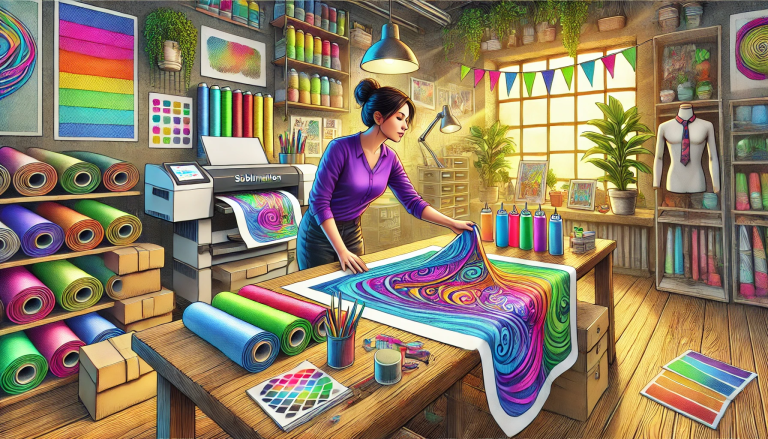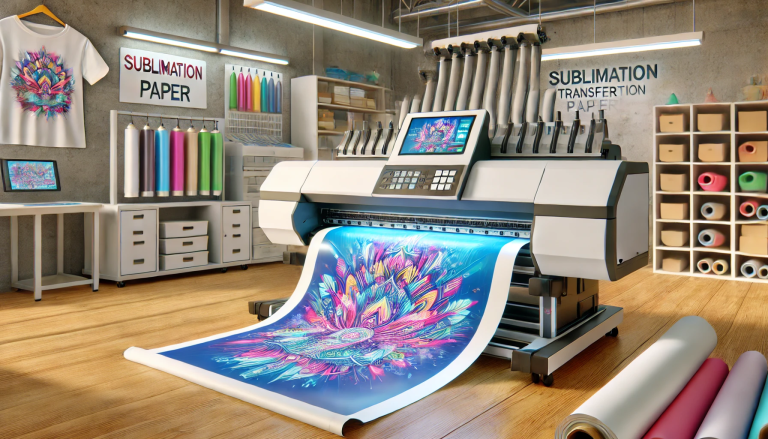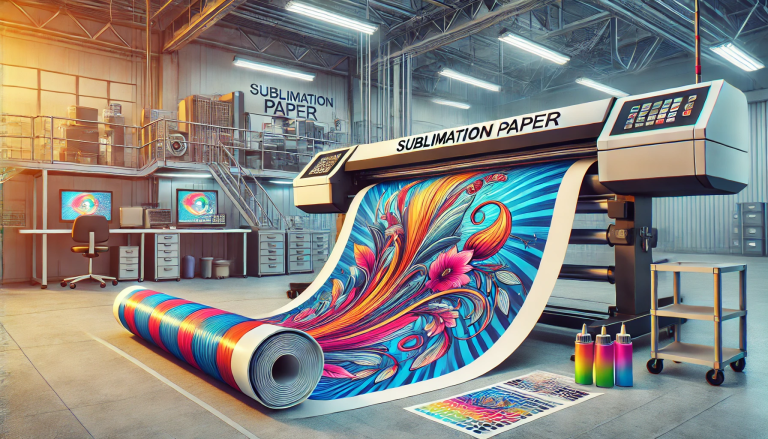- Item Code: CMFD50
- Weight: 50gsm
- Core Size: 2/3 Inch
- Available Width: 210/420/610/914/1118/1300/1600/1620/1800/1900/3200mm
- Available Length: Mini Roll / Jumbo Roll
- Package: Carton/Pallet
Custom mugs have become a popular choice for gifts, promotional items, and home décor. Whether you’re creating personalized gifts or branding items for your business, the key to producing high-quality, long-lasting mug prints lies in selecting the right transfer paper for mugs. In this article, we’ll explore the different types of transfer paper available, how to use it effectively, and tips for achieving professional-grade results.
What is Transfer Paper for Mugs?
Transfer paper is a specially coated paper designed to print graphics or designs directly from a printer before transferring them onto a surface using heat and pressure. For mugs, transfer paper is essential for creating custom designs that are durable, vibrant, and resistant to fading. There are two primary types of transfer paper for mugs:
- Sublimation Transfer Paper: Ideal for mugs with a polymer coating, where the ink transitions from a solid to a gas during the heat press process, bonding permanently to the surface.
- Standard Heat Transfer Paper: Suitable for ceramic mugs without a polymer coating, where the ink adheres to the surface during the heat press.
Types of Transfer Paper for Mugs
- Sublimation Transfer Paper
- Materials: Polymer-coated or sublimation-ready mugs.
- Process: Uses sublimation ink to create vibrant, full-color designs. The ink vaporizes and bonds to the polymer coating during the heat press process.
- Durability: Highly durable and resistant to fading, making it ideal for long-term use.
- Applications: Perfect for custom promotional mugs, personalized gifts, and sublimation-specific mugs.
- Standard Heat Transfer Paper
- Materials: Ceramic mugs and other heat-safe surfaces.
- Process: Uses standard heat transfer ink to bond with the mug’s surface. The design adheres to the mug after the heat press process.
- Durability: Generally less durable than sublimation prints but suitable for casual use.
- Applications: Suitable for short-term projects or mugs that don’t require the durability of sublimation printing.
- Holographic or Specialty Transfer Paper
- Materials: Ideal for ceramic and sublimation mugs.
- Process: Adds unique effects like glitter, foil, or holographic designs to your mugs.
- Durability: Varies depending on the type of paper and ink used.
- Applications: Great for creating eye-catching promotional items or personalized gifts with a creative touch.
How to Use Transfer Paper for Mugs
Using transfer paper for mugs involves a few key steps to ensure the best results. Here’s a step-by-step guide:
- Choose the Right Mug:
- For sublimation: Use mugs with a polymer or sublimation-ready coating.
- For standard heat transfer: Use uncoated ceramic mugs or other heat-safe surfaces.
- Design Creation:
- Create your design using graphic design software such as Adobe Photoshop, Illustrator, or CorelDRAW.
- Ensure the design fits the mug’s surface area and follows any guidelines provided by the transfer paper manufacturer.
- Printing:
- Load the transfer paper into your printer. Ensure the printer is calibrated and set to the appropriate settings (e.g., mirror image for sublimation prints).
- Print the design onto the transfer paper. Allow the print to dry completely before proceeding.
- Heat Press Application:
- Preheat your heat press to the recommended temperature (e.g., 380°F to 400°F or 190°C to 205°C for sublimation, 350°F to 370°F or 175°C to 188°C for standard heat transfer).
- Place the printed side of the transfer paper onto the mug, ensuring it is centered and smooth.
- Cover the transfer paper with a silicone heat press pad or a sheet of parchment paper to protect the press.
- Apply the heat press for the recommended time (e.g., 30-60 seconds for sublimation, 15-30 seconds for standard heat transfer). Ensure even pressure is applied across the mug.
- Cooling and Peeling:
- Allow the mug to cool for a few minutes after the heat press process.
- Carefully peel the transfer paper away from the mug (remove the paper while still warm for sublimation prints; wait until cool for standard heat transfer).
Tips for Success with Transfer Paper for Mugs
- Clean the Mug:
- Ensure the mug is clean, dry, and free of dust or grease before applying the transfer paper.
- Use the Right Ink:
- For sublimation: Use high-quality sublimation ink designed for polymer-coated mugs.
- For standard heat transfer: Use ink compatible with the transfer paper and mug surface.
- Test Prints:
- Conduct test prints to ensure the design, ink, and transfer paper work well together. Adjust settings as needed.
- Handle with Care:
- Avoid touching the printed area of the mug after transferring the design to prevent smudging or damage.
- Store Transfer Paper Properly:
- Keep transfer paper stored in a cool, dry place to prevent moisture absorption, which can affect print quality.
Common Challenges and Solutions
- Fading or Peeling:
- Cause: Inconsistent heat press settings, low-quality ink, or incorrect transfer paper.
- Solution: Follow the manufacturer’s guidelines for temperature, pressure, and time. Use high-quality materials and conduct test prints.
- Blurred or Smudged Designs:
- Cause: Improper paper alignment or insufficient drying time before heat pressing.
- Solution: Ensure the transfer paper is placed correctly and allow printed designs to dry completely before heat pressing.
- Inconsistent Colors:
- Cause: Sublimation ink not fully vaporizing or printer calibration issues.
- Solution: Use a high-quality sublimation ink and calibrate your printer regularly.
- Damage to the Mug:
- Cause: Excessive heat or uneven pressure during the heat press process.
- Solution: Adjust the heat press settings and ensure even pressure is applied during the transfer process.
Conclusion
Transfer paper for mugs is a versatile and essential tool for anyone looking to create custom, high-quality mug designs. Whether you’re using sublimation transfer paper for polymer-coated mugs or standard heat transfer paper for ceramic mugs, the right materials and techniques can make all the difference.
By understanding the different types of transfer paper, following proper printing and heat press procedures, and addressing common challenges, you can achieve professional-grade results that stand out. Whether you’re running a small business, creating personalized gifts, or adding a creative touch to your home décor, transfer paper for mugs opens up endless possibilities for customization and innovation.
Sublimation Ink Transfer Paper, Transfer Paper for Mugs, Epson Ds Transfer Photo Paper, Fast Dry Sublimation Paper, Soft Sublimation Cotton Paper, The Best Sublimation Paper, Sublimation Transfer Paper for Laser Printer, Digital Sublimation Transfer Paper, Sublimation Paper Heat Press, Sublimation Transfer Printing Paper, Sublimation Paper for Cups, Epson Ds Transfer Adhesive Textile Paper, Large format Sublimation Paper, Good Sublimation Paper, Transfer Paper for Mugs, Printer Sublimation Paper, Best Sublimation Paper for T Shirts, Sublimation Paper Brands, Cotton Sublimation Transfer Paper, Sublimation Transfer Paper for Laser Printer, Sublimation Printer Paper for Shirts, Best Sublimation Paper for Phone Cases, Heat Transfer Paper for Epson Printer, Epson Ds Transfer Adhesive Textile Paper, Heat Press Paper for Mugs, Sublimation on Cotton Transfer Paper, Transfer Paper for Mugs, Sublimation Transfer Paper for Laser Printer, Epson Ds Transfer Adhesive Textile Paper,





